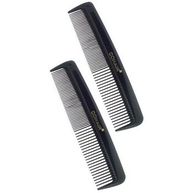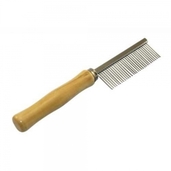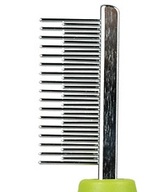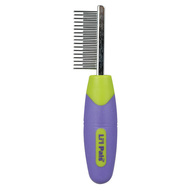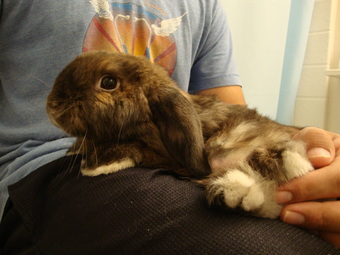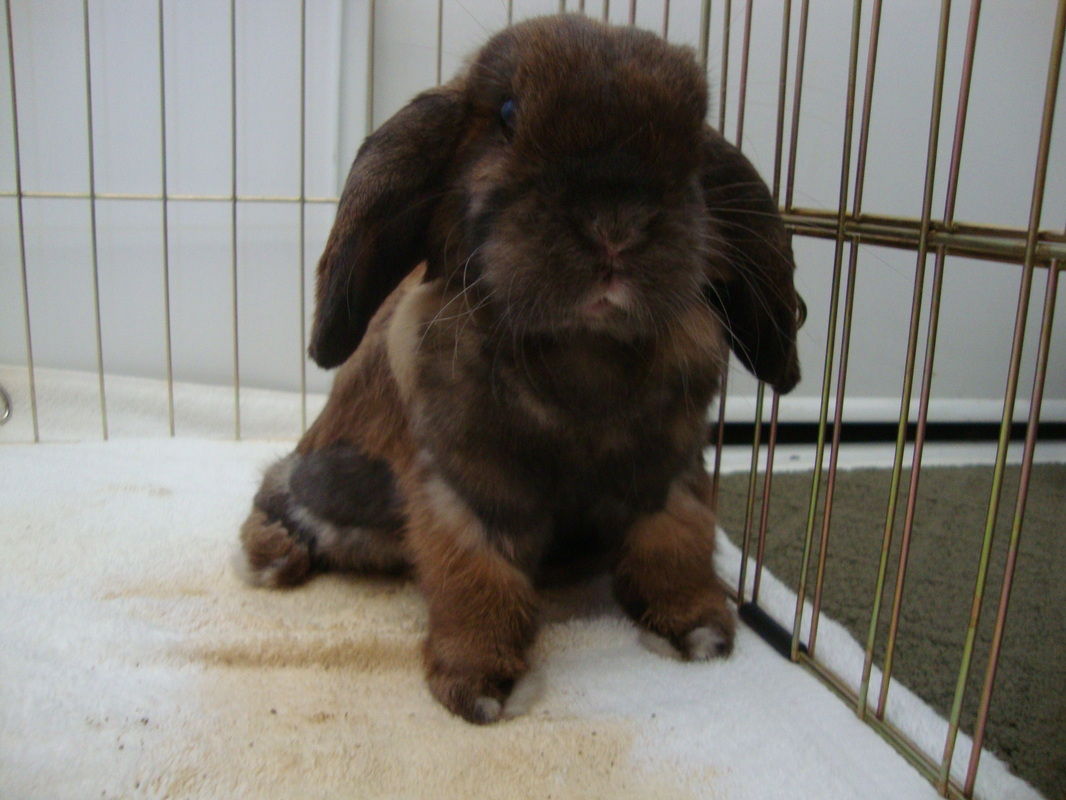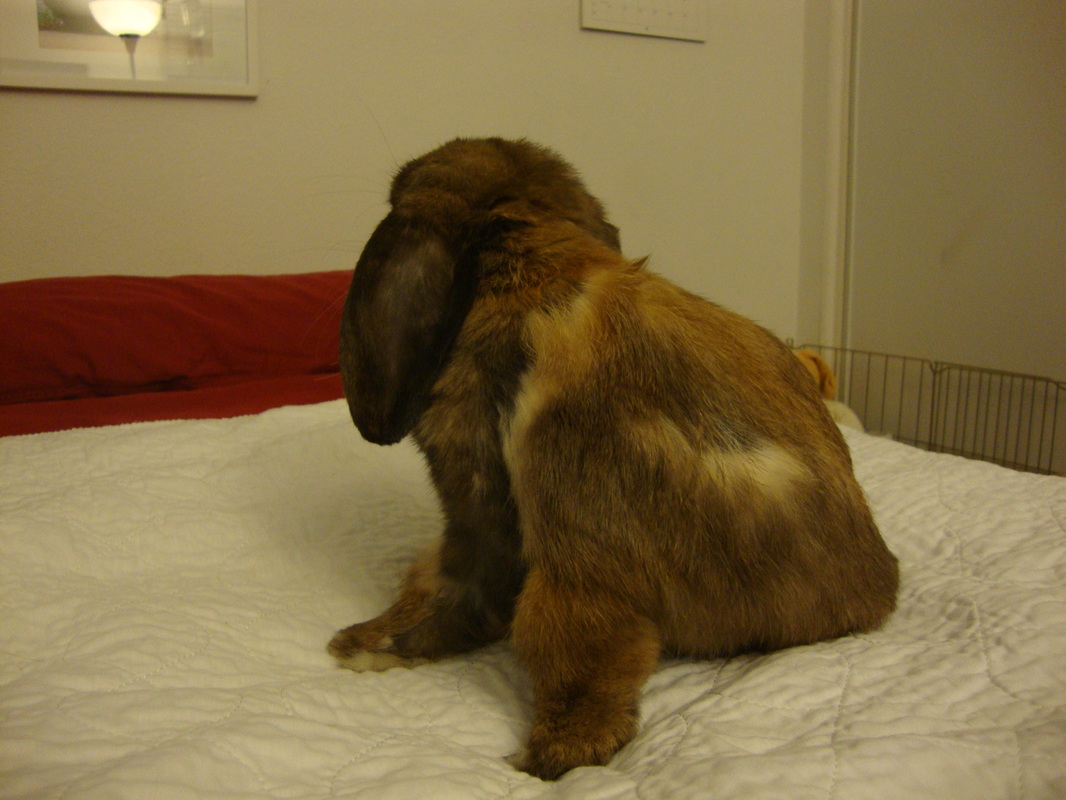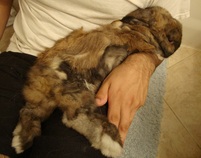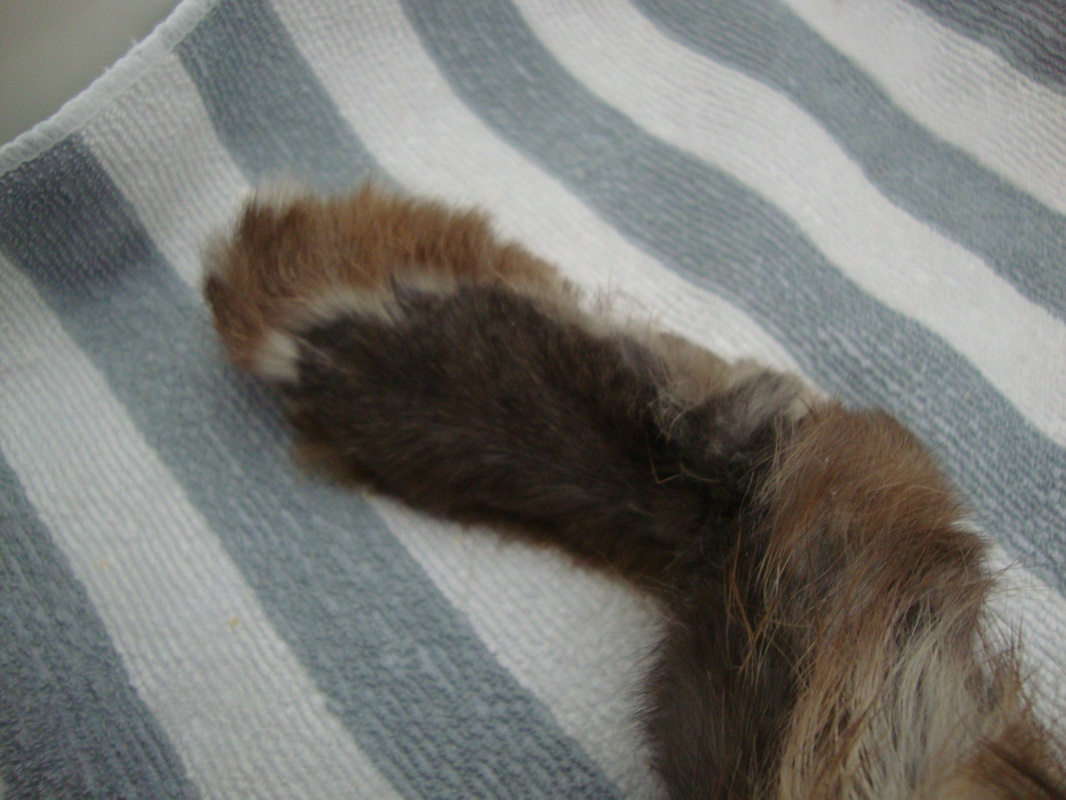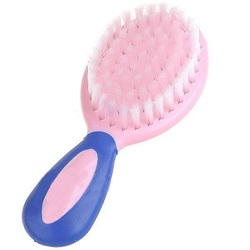Grooming |
Grooming tips for your disabled rabbit.
|
Grooming and the Disabled Rabbit
Rabbits are known for being fastidious groomers, but disabled rabbits often have trouble keeping themselves clean and tidy. Grooming can be a great opportunity for one-on-one bonding time with your rabbit, but it is also necessary to help keep excess hair off their bodies. Rabbits shed constantly (though the degree of shedding varies from rabbit to rabbit). When they groom themselves, they ingest hair. Unlike cats, rabbits are not able to vomit, so "hairballs" have the potential to clog their sensitive stomachs and cause a slowing down of their digestive tract- which can be very dangerous for a rabbit. For a less mobile disabled rabbit that may already be prone to a slower digestive system, an accumulation of hair can be even more dangerous, so the need to prevent this is very important. An effective brush can help to clear excess hair to keep their coat clean and healthy- and their tummies clear.
What to Use
Here are some brush options:
3. Zoom Groom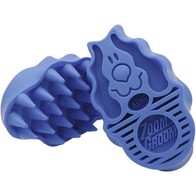
A newer option for a rabbit brush is a brush called a Zoom Groom. The Zoom Groom is a rubber brush with thick rubber bristles that attract hair like a magnet. It doesn't pull, yank or scratch and is gentle on a rabbit's sensitive skin. It loosens hair easily and is even said to help stimulate natural oils in the coat.
|
4. Furminator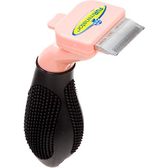
While a pricier grooming option, the Furminator is becoming more popular for rabbit grooming. It has a stainless steel edge that reaches deep beneath a rabbit's topcoat to safely remove loose undercoat and hair. It is said to reduce shedding by up to 90%. Just be sure to be gentle with the rough edges.
|
Recommendation: Li'l Pals Pet Comb
|
We use and recommend the Li'l Pals Pet Comb. This is a great small comb with smooth, rounded metal bristles that are very sensitive on a rabbit's skin. The comb has long teeth that penetrate deep into a rabbit's undercoat with alternating short teeth to collect the loose hair. It works well for working out mats, collecting dirt, and removing excess hair. We find the alternating bristle sizes to be unique and extra effective, especially during heavy shedding periods. This comb is very inexpensive and often readily available at pet supply stores.
|
*We recommend against metal slicker brushes as these can scratch and irritate a rabbit's thin, sensitive skin.
How to Do It
|
What are mats?
Mats are entanglements of hair that can form in your rabbit's fur. They could be knots created in their undercoat or topcoat, or they could be formed when dirt, hay, litter, etc. becomes tangled in their fur. Mats are especially common in long haired rabbits. Frequent brushing can help to prevent them, but careful attention must be applied to help remove them. If you notice any mats in your rabbit's fur, brush them out gently with a comb. Begin at the ends of the mat and work your way towards your rabbit's body while loosening and detangling the mat with your comb as you go, but be careful not to pull on your rabbit's skin. The easiest way to do this is to use the fine bristles on your comb to separate the tangled hairs with a gentle "picking" action. Never use scissors to remove a mat. Rabbit skin is very delicate and it is far too easy to accidentally nick the skin. A mat will work itself out with time and careful combing, but it you encounter one that is particularly persistent, consult a professional groomer to have the mat trimmed out with electric clippers. Many rescues also provide grooming sessions for a small donation.
What is molting?
Molting is when a rabbit goes through a period of heavy shedding in which they "blow" their coats. This means that they shed their old topcoat to allow a new undercoat to grow in. Molting is often accompanied by tufts of fur, changes in fur color, bald spots, and an overall disheveled and shaggy appearance. The common belief is that rabbits molt every three months. Most owners will find, though, that each rabbit has his or her own shedding and molting schedule. Some will just shed lightly throughout the year, others will molt a few times a year and shed at other times, others may seem like they are always molting. The important thing is to maintain grooming during shedding periods and increase grooming during molting periods. The more you groom, the less hair your rabbit will be ingesting.
Mats are entanglements of hair that can form in your rabbit's fur. They could be knots created in their undercoat or topcoat, or they could be formed when dirt, hay, litter, etc. becomes tangled in their fur. Mats are especially common in long haired rabbits. Frequent brushing can help to prevent them, but careful attention must be applied to help remove them. If you notice any mats in your rabbit's fur, brush them out gently with a comb. Begin at the ends of the mat and work your way towards your rabbit's body while loosening and detangling the mat with your comb as you go, but be careful not to pull on your rabbit's skin. The easiest way to do this is to use the fine bristles on your comb to separate the tangled hairs with a gentle "picking" action. Never use scissors to remove a mat. Rabbit skin is very delicate and it is far too easy to accidentally nick the skin. A mat will work itself out with time and careful combing, but it you encounter one that is particularly persistent, consult a professional groomer to have the mat trimmed out with electric clippers. Many rescues also provide grooming sessions for a small donation.
What is molting?
Molting is when a rabbit goes through a period of heavy shedding in which they "blow" their coats. This means that they shed their old topcoat to allow a new undercoat to grow in. Molting is often accompanied by tufts of fur, changes in fur color, bald spots, and an overall disheveled and shaggy appearance. The common belief is that rabbits molt every three months. Most owners will find, though, that each rabbit has his or her own shedding and molting schedule. Some will just shed lightly throughout the year, others will molt a few times a year and shed at other times, others may seem like they are always molting. The important thing is to maintain grooming during shedding periods and increase grooming during molting periods. The more you groom, the less hair your rabbit will be ingesting.
Face
Disabled rabbits that have difficulty washing or are no longer able to wash their faces often love to have their humans' help. Try taking a soft washcloth, moistening it slightly with warm water, and wiping it gently along their face from nose to ears. Be sure not to actually get their face wet; you want the washcloth to just slide smoothly across their face. We find that most disabled rabbits love this special grooming.
Eyes
As you groom your rabbit, be sure to check their eyes. Remove any crust from the corners, brush the hair around the eyes (very) carefully, and check for any discharge, redness or excess wetness. Discharge and redness could indicate an infection; excess wetness could indicate teeth problems. If you notice any of these symptoms, talk with your vet.
Scent Glands
A part of grooming that many rabbit owners overlook is cleaning a rabbit's scent glands. Rabbits have scent glands located under their chin and in their genital area. They use these glands to mark their territory and communicate with other rabbits. Over time, their anal scent glands can get clogged with a smelly waxy-like substance that can range in color from a mild yellow to a dark brown. Most rabbits are fairly good at keeping their scent glands clean, but disabled rabbits will often have trouble accessing their scent glands and so may need your help. Try to check them whenever you do a thorough grooming session. To clean them, you just need a few Q-tips, some tissues, and some warm water, Vaseline or mineral oil. Get your rabbit upside down (best to have someone help you) and find the glands. They look like two slits on either side of the anus. You may need to expose them by gently parting the skin on one side of the anus with your fingers. When you find the glands, simple dab the Q-tip in some water/Vaseline/mineral oil and carefully swab away any buildup. Rolling the Q-tip can help to loosen any stubborn buildup. Just be sure to scrub gently, as the skin there is very delicate. Wipe any buildup on the tissues, give your rabbit some extra pets and praise, and that's it!
Here's a video to help you in case you have trouble:
Here's a video to help you in case you have trouble:
Precautions and Tips
- The average rabbit should be brushed once a week. Longer haired rabbits, such as Angora breeds, will require almost daily brushing and possibly even professional grooming assistance.
- During heavy shedding or molting periods, be sure that you have lots of hay and water available for your rabbit. They will need it to help move the extra hair through their system.
- If your rabbit has never been groomed before or is very uncomfortable with grooming, you will need to do some training with them. Start with a soft brush or a glove. Get them used to being touched and brushed. Talk to them during these sessions, give them lots of praise and extra pets. Over time you can start introducing different brushes and combs as they start to become more comfortable.
- Typically, you will only need to groom your rabbit's face, neck, back, sides and bottom. Except in cases of long-haired rabbits, it is not common for a rabbit to need their legs or stomach groomed.
- Unless needed, do not groom the bottom of your rabbit's feet. Rabbit's feet are very sensitive and the hair there is meant to be thicker and more densely packed in order to provide cushion and protection for the foot. Grooming there can leave your rabbit's feet vulnerable.
Recommendation: Oxbow Papaya Fruit Plus Tablets
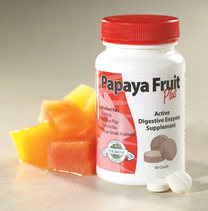
We use and recommend a pineapple or papaya tablet supplement, such as Oxbow's Papaya Fruit Plus Tablets, to add to your rabbit's diet during shedding and/or molting periods. These tablets contain the active enzymes papain and bromelain, which aid in digestion. Pineapple and papaya have long been noted for their ability to break down hair (and other blockages) in the stomach. You can also find pineapple and papaya tablet supplements in most health food stores. Even better than tablets is a piece of fresh pineapple core (not juice). The enzymes are even more potent in these fresher forms.
*Please note that this supplement is meant only as that- a supplement. There is no guarantee of its success, but we do feed them ourselves and believe that there is some preventative benefit to their use.
*Please note that this supplement is meant only as that- a supplement. There is no guarantee of its success, but we do feed them ourselves and believe that there is some preventative benefit to their use.
Brush Massage
Make grooming a relaxing experience by using your brush to do a gentle massage. As many disabled rabbits are not able to groom themselves normally (or at all, in some cases), gentle brushing can imitate that soft grooming sensation and really feel wonderful to your rabbit.
|
We recommend using a baby brush. Pick one with very soft bristles- nothing too sharp or pointy.
To massage, use gentle strokes down your rabbit's forehead towards the back of their head and over their shoulders. Do soft strokes in and around your rabbit's ears (especially for lop rabbits). Brush down your rabbit's sides (especially for paralyzed rabbits that lay on one side) and down your rabbit's hips (especially for rabbits with arthritis). Stroke the underside of your rabbit's feet (especially for rear-end paralyzed rabbits). Start slowly here though. The brushing will stimulate the sensitive nerves in the feet and, for some rabbits, this can be a bit uncomfortable. Just do a few light strokes. Keep an eye on how your rabbit is enjoying the brushing and keep grooming as you see fit. Think of areas that they may not be able to reach or areas that may be tense. Overall, this process can really help to increase circulation and stimulate the nerves. Disabled rabbits just love it!
|

